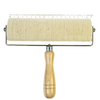Felt Roller: Maintenance & Care - Make The Most Out of Your Roller Sleeve
- by Amanda Cochrane
When it comes to achieving a flawless, streak-free finish on paint, varnish, or gilding projects, the felt roller is an essential tool for both professionals and DIY decorators. Known for its smooth, lint-free application, a felt roller can make all the difference when working on delicate or detailed surfaces - whether you’re applying metallic finishes, varnishing wood, or coating fine plasterwork.
Felt Roller: What It Is and Why It Matters
A felt roller is a high-density, smooth-surfaced roller sleeve made from compressed wool or synthetic felt fibres. Unlike foam or mohair rollers, which are designed for thicker coatings, a felt roller provides an ultra-even film, perfect for applying thin or specialised materials where every detail counts.
Because of its fine texture and excellent absorption, the felt roller allows for:
· Smooth, streak-free finishes on high-gloss paints, metallics, and varnishes
· Precise control over coverage on flat or contoured surfaces
· Minimal lint shedding, making it ideal for finishing work and restoration
· Durability, with proper care, extending its lifespan significantly
Used widely in gilding, signwriting, furniture finishing, and decorative paintwork, a well-maintained felt roller ensures consistency, reduces waste, and saves both time and money over the long term.
Why Felt Roller Care Is So Important
A clean, properly stored felt roller not only lasts longer but also delivers a far superior finish. When neglected, residue build-up, drying paint, and improper storage can cause uneven coverage, shedding, and drag marks.
Maintaining your felt roller is about more than hygiene; it’s about preserving the integrity of your tools and achieving consistent, high-quality results across every job.
Whether you’re working with gilding size, oil-based varnish, or metallic paints, routine cleaning after each use will ensure the fibres remain soft, flexible, and ready for the next project.
How to Clean a Felt Roller Properly
Cleaning a felt roller doesn’t have to be complicated, but it does require care and attention to avoid damaging the felt surface. Follow these steps for the best results:
1. Remove Excess Product Immediately
As soon as you’ve finished using your roller, scrape off as much of the paint or coating as possible using a roller scraper or palette knife. Avoid letting the product dry into the fibres, as this can permanently stiffen the felt.
2. Choose the Right Cleaning Solution
For water-based products, rinse your felt roller thoroughly under warm water with mild soap.
For oil-based or solvent-based finishes, use a suitable solvent such as white spirit or turpentine. Swirl gently until the roller is free of residue, then rinse in clean water.
3. Rinse and Repeat
Continue cleaning until the water or solvent runs clear. This step ensures no pigment or varnish remains trapped within the felt, which could affect your next application.
4. Gently Dry and Reshape
Pat dry with a lint-free cloth, then allow your roller to air-dry fully. Avoid placing it near heat sources, as this may distort or shrink the felt. If possible, stand it upright to retain its shape.
5. Store It Correctly
Once dry, wrap your felt roller in a clean, dry cloth or resealable plastic bag to prevent dust accumulation. Store it in a cool, dry place away from direct sunlight.
When to Replace Your Felt Roller
Even with excellent maintenance, every roller has a natural lifespan. You may need to replace your felt roller when you notice:
· Uneven texture or hard spots in the felt
· Shedding or lint appearing on the surface during application
· Reduced paint absorption or streaking
At Wrights of Lymm, we supply a wide range of replacement felt rollers in multiple sizes and sleeve densities to suit all types of finishing and restoration projects. Keeping a few spares on hand ensures that you’re never caught short in the middle of a critical job.
Browse the full selection here: Felt Rollers Collection.
Tips for Extending the Life of Your Felt Roller
To get the best performance and longevity from your roller, keep these expert tips in mind:
· Avoid overloading with paint or size; it causes streaks and increases clean-up time.
· Always clean immediately after use; dried coatings are almost impossible to remove.
· Label your rollers if you use multiple finishes (e.g., one for varnish, one for size).
· Do not soak overnight - long exposure to solvents or water can degrade the felt backing.
· Rotate use between several rollers to reduce wear on any single one.
With these habits in place, a professional-grade felt roller can remain in excellent condition for many applications, maintaining consistent texture and coverage across surfaces.
Felt Roller: A Tool Worth Caring For
When maintained correctly, a felt roller can deliver hundreds of flawless applications, whether you’re restoring a period frame, applying gilding size, or finishing a fine lacquered surface.
Proper cleaning, drying, and storage will protect your investment and ensure every finish reflects your craftsmanship and attention to detail.
At Wrights of Lymm, we combine exceptional product quality with fast delivery and expert advice. Whatever your project, our team can help you choose the right tools and materials for a professional result.
Ready to upgrade your toolkit?
Explore the Felt Roller Collection today or call 01925 752226 for friendly guidance on selecting the perfect roller for your next project.
- Posted in:
- felt roller






